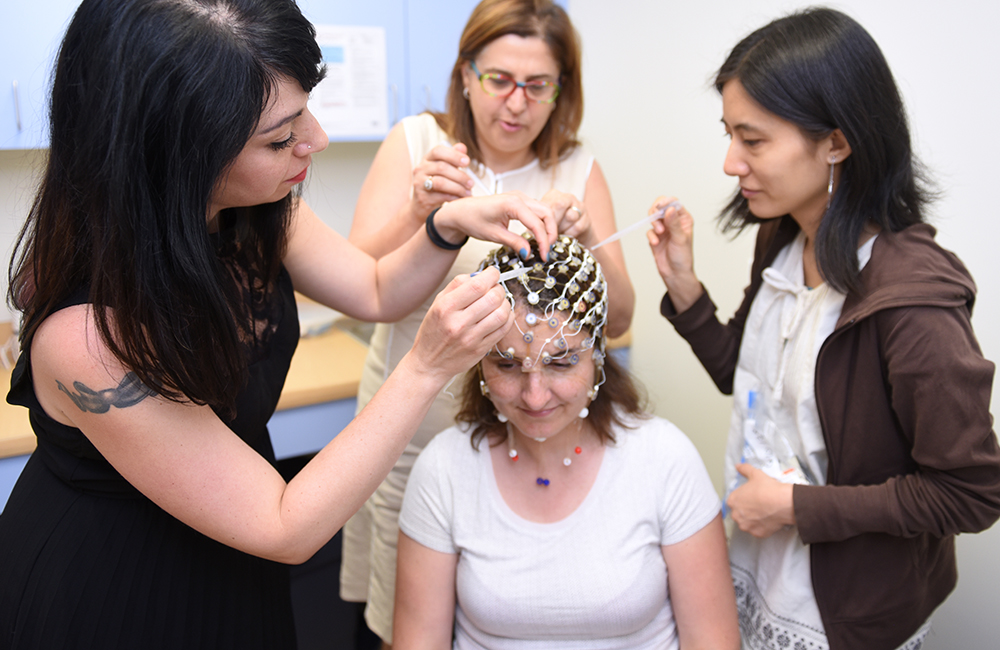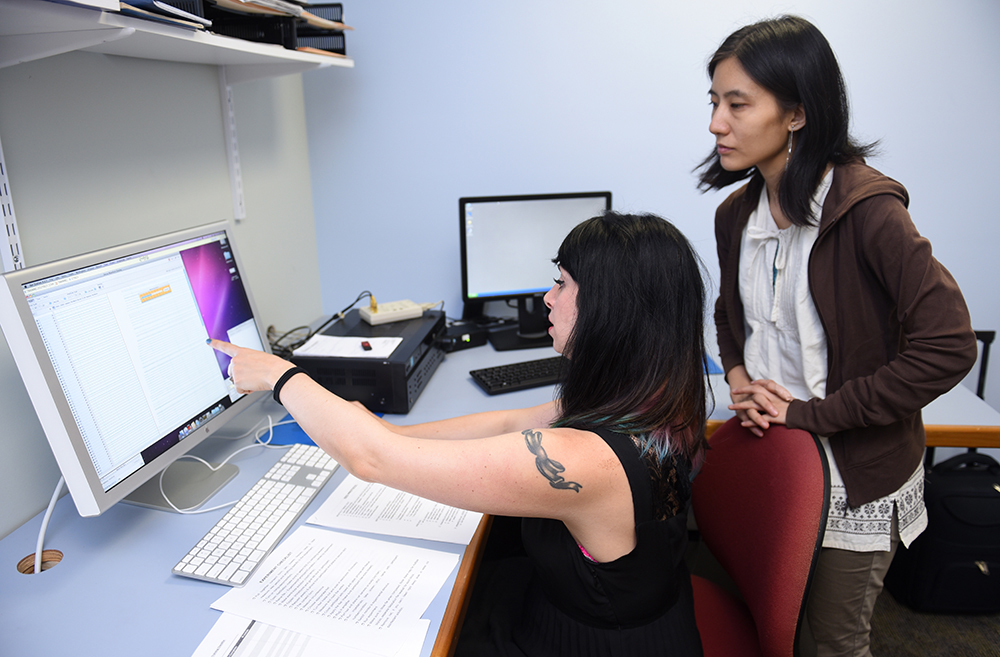Adelphi University professors are charting new territories in Speech Pathology while giving students hands-on learning experiences in Neuroscience.
Speech pathology students rarely get a chance to run their own experiments. They’re often taught how to consume research, but not how to produce it.
Adelphi University professors are changing that by incorporating new technologies into their courses. These tools help students better understand how speech and language are processed in the brain, and how they can use their findings to assist people with communication disorders.

“I started last fall at Adelphi, and when I came in I brought updated equipment,” says Melissa Randazzo, Ph.D., assistant professor in the Department of Communication Sciences and Disorders at Adelphi University. “Before, we had a 32-channel EEG system—meaning 32 electrodes on the sensor net—and I brought in a whole new system with 128 electrodes.”
Sensor nets indicate how much of the head is covered by the EEG machine. The more electrodes in the sensor net, the more data that’s provided and the more accurate the results.
“One hundred twenty-eight channels is an ideal amount to cover the head of an adult and to examine processing in brain regions related to speech language,” says Dr. Randazzo. “The 32-channel nets only give one-fourth the amount of data of the 128-channel nets.”
With this new technology, the department created a course in EEG studies for master’s degree students.
“Our EEG class is designed specifically for future speech-language pathologists,” says Dr. Randazzo. “The content of the course is designed to not only encompass research methods and the application of EEG to the big questions in our field, but it’s also a stepping-stone to introduce students to research and the path to Ph.D. studies and future careers as speech and hearing scientists.”
This course is a first for Adelphi University, and a rarity for the field as a whole. Most EEG classes are only offered for neuroscience students, despite EEG’s increasing value for the field of speech-language pathology.
“EEG is ideal for examining speech and language processing in people who have communication disorders because it’s not invasive,” says Dr. Randazzo. “It can tell us how speech sounds are represented in the brain and how people perceive language. These are important questions that help us to learn more about diagnosing these disorders, and it helps us generate new treatments or advance the treatment in the field.”
Students jumped at the opportunity to gain hands-on experience and begin their own neuroscience research.
“I gave students the option to work on an idea and develop a proposal to present on Research Day—Adelphi’s annual student research conference,” says Dr. Randazzo. “Every student in the class opted to do this, and some of them won awards, which was really exciting.”
Dr. Randazzo then offered two EEG labs in the summer. These labs allowed the master’s degree students to learn how to use the equipment and build their own experiments.

“I didn’t think I was going to get students who were so dedicated that they wanted to spend their summer in the lab,” says Dr. Randazzo. “Now we have about four functioning experiments that have been developed by our speech-language pathology master’s students.”
The student experiments range from researching language representation in adults with aphasia to studying conflict effects in language representation in adults who stutter.
“Few departments are able to offer master’s degree students such unique opportunities for research engagement,” says Reem Khamis-Dakwar, Ph.D., associate professor and chair of the Department of Communication Sciences and Disorders at Adelphi. “The incorporation of neuroscience in investigating communication disorders and speech therapy makes our clinicians both well-rounded and highly trained in multiple aspects of the profession.”
The department is also developing a new teaching and training lab in Linen Hall.
“We’re going to teach classes out of that lab, so we can now expand the class for undergraduates and they’ll have hands-on lab experience doing EEG,” Dr. Randazzo says.
This will help Adelphi support a new generation of Ph.D. students in the field of speech pathology, which is sorely lacking in clinicians who conduct original research.
“We have a shortage of Ph.D.s in our field,” says Dr. Randazzo. “This, to me, is especially problematic because our field is predominantly women. We always talk about how women are underrepresented in science or neuroscience, but we’re not giving them the tools that they need to pursue this or to even know that they want to.”
If the response from the students is any indication, undergraduates should welcome this opportunity with open arms.
“Our master’s students are very proud of themselves for taking this leap,” Dr. Randazzo says. “Several of them told me they never thought that they could do something like this or that they would like it so much. I think they’re taking a lot of pride in knowing that Adelphi is a leader in our field.”
For further information, please contact:
Todd Wilson
Strategic Communications Director
p – 516.237.8634
e – twilson@adelphi.edu